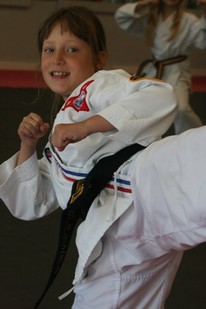 Anna is now a black belt!
Anna is now a black belt! After seeing a board breaking demonstration in school one day, my seven-year-old daughter decided she wanted to become a black belt. I signed her up happily, knowing it would be good for her mind as well as her body.
When my daughter went to her first class, I noticed that she could barely do
a push-up. I can remember seeing her arms shake as she tried to lift her body
up and put it back down again. And I wasn’t even wearing my glasses.
As I watched, I wondered if she would ever be able to keep up with the kids
in her class. They were so fit. And the forms they were doing seemed so
complicated. Would my little Anna ever really be able to become a black
belt?
Day after day, I was amazed at how her enthusiastic instructors allowed her
to grow at her own pace. At how they didn’t seem the least bit concerned about her small stature or lack of muscle power. At how they encouraged her…and motivated her, helping her to improve steadily and meet each new challenge with an open mind and heart.
Little by little, she got stronger and stronger.
Now, ten months later, she cranks out push-up after push-up. Her arms are strong, her legs are strong, and every day she is getting closer and closer to her goal – becoming a black belt.
Teaching someone to read is a very similar process. It takes time. And energy. And lots of positive encouragement. And patience.
When my daughter went to her first class, I noticed that she could barely do
a push-up. I can remember seeing her arms shake as she tried to lift her body
up and put it back down again. And I wasn’t even wearing my glasses.
As I watched, I wondered if she would ever be able to keep up with the kids
in her class. They were so fit. And the forms they were doing seemed so
complicated. Would my little Anna ever really be able to become a black
belt?
Day after day, I was amazed at how her enthusiastic instructors allowed her
to grow at her own pace. At how they didn’t seem the least bit concerned about her small stature or lack of muscle power. At how they encouraged her…and motivated her, helping her to improve steadily and meet each new challenge with an open mind and heart.
Little by little, she got stronger and stronger.
Now, ten months later, she cranks out push-up after push-up. Her arms are strong, her legs are strong, and every day she is getting closer and closer to her goal – becoming a black belt.
Teaching someone to read is a very similar process. It takes time. And energy. And lots of positive encouragement. And patience.
It takes a strong belief in knowing that every kid can achieve the goal before him or her.
And it takes a knowledgeable teacher.
If you are a parent of a beginning reader, or even a teacher for that matter, you might worry that your child (or your group of kids) will never get it– that they’re too far behind, have too many problems, are too immature, etc.
You might think that reading is too difficult of a process for them to get. That it’s just too complicated.
But it’s not.
If you break down the reading process and introduce it one skill at a time, it’s really very simple.
The key is to give everyone the workout they need as often as possible, regardless of how they first come to
you. This requires that you know where they are, what they need, and how to encourage them in a positive way. It also
requires that you stay focused on your goal.
It won’t happen overnight, but with the right training, your kids can succeed — even the ones who come in barely able to recognize a single letter or sound. By utilizing Best Practices and encouraging your kids to meet new goals on a
daily basis, you can help them achieve their own “black belts” in reading and writing — and have fun doing so.
All the best and much
success,
Katy Huller
For more information on how to get your kindergarten students reading and
writing, read Kinders Can! READ and WRITE!
And it takes a knowledgeable teacher.
If you are a parent of a beginning reader, or even a teacher for that matter, you might worry that your child (or your group of kids) will never get it– that they’re too far behind, have too many problems, are too immature, etc.
You might think that reading is too difficult of a process for them to get. That it’s just too complicated.
But it’s not.
If you break down the reading process and introduce it one skill at a time, it’s really very simple.
The key is to give everyone the workout they need as often as possible, regardless of how they first come to
you. This requires that you know where they are, what they need, and how to encourage them in a positive way. It also
requires that you stay focused on your goal.
It won’t happen overnight, but with the right training, your kids can succeed — even the ones who come in barely able to recognize a single letter or sound. By utilizing Best Practices and encouraging your kids to meet new goals on a
daily basis, you can help them achieve their own “black belts” in reading and writing — and have fun doing so.
All the best and much
success,
Katy Huller
For more information on how to get your kindergarten students reading and
writing, read Kinders Can! READ and WRITE!

 RSS Feed
RSS Feed
